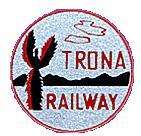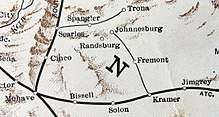Trona Railway
 | |
| Reporting mark | TRC |
|---|---|
| Locale | Mojave Desert, California |
| Dates of operation | March 12, 1913–Present |
| Track gauge | 4 ft 8 1⁄2 in (1,435 mm) standard gauge |
| Length | 30.5 miles (49.1 km) |
| Headquarters | Trona, California |
The Trona Railway (reporting mark TRC) is a 30.5 mi (49.1 km) short-line railroad owned by Searles Valley Minerals. The TRC interchanges with the Union Pacific Railroad (former Southern Pacific Transportation Company) at Searles, California.
History
The railroad was built by the American Trona Company in 1914, to serve the mining company's shipping from Searles Station to a junction with the Southern Pacific Railroad.[1] The company and its Trona Railway has had various subsequent owners, including American Potash & Chemical Corporation, Kerr-McGee Corporation, IMC Global, Sun Capital, LLC, before the current ownership of Searles Valley Minerals, Inc. On Dec. 27 2007, Karnavati Holdings, a subsidiary of Nirma Limited, acquired all of Searles Valley Minerals, Inc.
The Trona Railway connects Trona with the Southern Pacific Railroad at Searls Station. The main line is 30.6 miles long, has a maximum grade of 1.9 % and has gentle curves, which permit a maximum speed of 70 miles per hour.
Construction

The idea of building a standard gauge railroad to replace mule-drawn wagons came from Stafford W. Austin, the receiver of the American Trona Corporation. The railroad would connect Searles Valley with a lower cost connection to the markets within the United States and to ocean ports for exports. On 27 September 1913 the wife of Joseph Hutchinson broke ground with an old fashioned plow, to start the construction of Trona Railroad. The work force of 400 included American, Chinese, Greek, Hindu, Mexican, Irish, Norwegian and Swedish workers. They finished the task within 6 months despite battling occasional sandstorms. The construction was event-free, apart from one runaway tank car down the track from Searles Station. This struck the construction train and derailed several cars without causing injuries. The construction of the 31 miles long track was completed by end of March 1914, and the first excursion was conducted in May 1914.
Steam locomotives

The operation began with two new oil-fired Baldwin 2-8-0 steam locomotives. They weighed 104 tonnes each and their boilers produced steam at 200 pounds pressure. When they were coupled together, they had a combined pulling capacity of 500 tons.
| Number | Builder | Type | Date | Works number | Notes[2] |
|---|---|---|---|---|---|
| 1 | Baldwin Locomotive Works | 2-8-0 | 1914 | 41157 | purchased new |
| 2 | Baldwin Locomotive Works | 2-8-0 | 1914 | 41158 | purchased new |
| 2701 | American Locomotive Company | 2-8-2 | 1914 | 54395 | built as Union Pacific Railroad #2701; purchased from Six Companies, Inc. at Hoover Dam about 1936 |
Passenger service
In addition to carrying inbound fuel oil and outbound fertilizer and chemical products from the new chemical plants in Searles Valley, the Trona Railway also carried passengers to and from Trona. Regular passenger services continued until 1937. A self-propelled coach for pupils of Westend, South Trona and Borosolvay to attend the school in Trona ran up to 1941. This coach was sold in 1941 to the California Western Railroad as their number M-200 for the Skunk Train from Willits, California, to Fort Bragg, California.[2] It was sold to the Niles Canyon Railway in 1975.
World War I
In 1914 Searles Lake was one of only two known potash deposits outside of Germany. By 1916 potash was transported via the Trona Railway to farmers, who needed fertilizer, to feed the nation during World War I.
Three Elephant Route
The name Three Elephant Route was created, because many of the railroad's employees were British and did not understand, why the company should hang on to its heritage of 20 mule teams. As the story goes, they felt that three elephants could have done the job as well, if not better, than a herd of mules. The slogan was used as a brand and logo, which adorned Trona Railway equipment into the late 1940s.[2]
Diesel locomotives
.jpg)
In April 1949 the Trona Railway purchased two new Baldwin DT-6-6-2000 locomotives (numbered 50 and 51) to replace three steam locomotives that were operating at the time. These weighed 180 tons each and had 2000 hp motors. These locomotives were unique in that they had center cabs, not the traditional cabs in the front.[2] Locomotive No 52 was a smaller Baldwin AS 616 that only developed 1,600 hp. Eventually, two more AS 616 locomotives were added to the fleet to bring the total to five. A small diesel-electric locomotive called Dinky was used for switching in the rail yards. A crew car was used for safety inspections of the rail track and to bring employees to the site of track maintenance.
Operations
The TRC handles 18,000 cars annually (1996 estimate). Commodities hauled include:
- Sulfuric acid
- Soda ash
- Potash
- Salt cake
- Borax
- Coal
- Minerals
- Material for the U.S. Naval Air Weapons Station China Lake
References
Bibliography
- Fickewirth, Alvin A. (1992). California railroads: an encyclopedia of cable car, common carrier, horsecar, industrial, interurban, logging, monorail, motor road, shortlines, streetcar, switching and terminal railroads in California (1851-1992). San Marino, CA: Golden West Books. ISBN 0-87095-106-8.
- Stindt, Fred A. (1996). American Shortline Railway Guide (5th ed.). Waukesha, Wisconsin: Kalmbach Publishing. ISBN 0-89024-290-9.
- Walker, Mike (1997). Steam Powered Video's Comprehensive Railroad Atlas of North America - California and Nevada (Post Merger ed.). Kent, United Kingdom: Steam Powered Publishing. ISBN 1-874745-08-0.